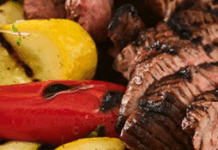Daniel Caudill
KMUW
In 1823, the grasslands would have covered much of the state, which was then part of the Missouri Territory. The prairie has gotten smaller, but what remains provides a window into our past.
To get an idea of what much of Kansas looked like in 1823, you need only to take a walk through the Konza Prairie Biological Station near Manhattan.
“… This side is burned every two years, and this side, historically, is burned every 20 years …”
That’s John Blair. He’s a biology professor at Kansas State University and the director of the biological station, which has more than 8,600 acres of land.
The station hosts a herd of about 200 bison who graze the area, and their activity, combined with controlled burning, helps researchers better understand the history of the Tallgrass Prairie and how to preserve it.
“We can look at how bison grazing and fire interact to influence the heterogeneity of the landscape and the plant communities that occur there,” Blair said.
Before white settlers arrived in Kansas in 1827, the Tallgrass Prairie covered 170 million acres of what’s now called North America — going all the way to modern-day Indiana, Ohio and even Canada.
But the tallgrass started to decline due to settlements and, primarily, agriculture.
And after nearly two centuries of farming in the region, the Tallgrass Prairie today is only about 4% of its peak size, with the bulk of it right here in eastern Kansas.
So why was Kansas’ piece of the Tallgrass Prairie saved from the plow?
“Because the Flint Hills were too rocky and had too much topographic relief to effectively be plowed,” Blair said.
Along with the once massive swaths of tallgrass came an abundance of grassland birds, like the now-endangered prairie chicken.
There would have also been a much higher number of herd animals roaming the state in the 1820s, like elk and bison.
And Bison work almost like nature’s ecologists, creating depressions in the ground called bison wallows that hold water and are home to diverse wildlife.
“So these wallows in the springtime become these temporary springtime ephemeral ponds, which is good for amphibians and aquatic insects,” Blair said.
Those herd animals attracted predators, many of which we no longer see in Kansas today. That includes timberwolves, black bears, and even grizzly bears.
One of the biggest changes to Kansas’ landscape over the last 200 years is the increased presence of trees and shrubs, or what Blair calls “woody vegetation.”
“Historically, fires were an integral part of why the tall grass prairie was tall grass prairie and not forest,” Blair said, “and it burned frequently from both natural causes – lightning induced fires – and because the indigenous people, the Native Americans here, used fire extensively.”
Today, the practice of burning the tallgrass is still employed at the Konza Prairie Biological Station and elsewhere in the Flint Hills.
It’s all about keeping the grass healthy and making sure that woody vegetation doesn’t creep in and take over the state’s last remaining sea of tallgrass – an iconic piece of Kansas history.
“Conserving that part of our American heritage, I think, is important for social and cultural reasons,” Blair said, “but also because it harbors a lot of biodiversity that we don’t find in other ecosystems.”
https://www.kmuw.org/the-range/2023-11-10/konza-prairie-biological-station-offers-a-window-into-kansas-past



